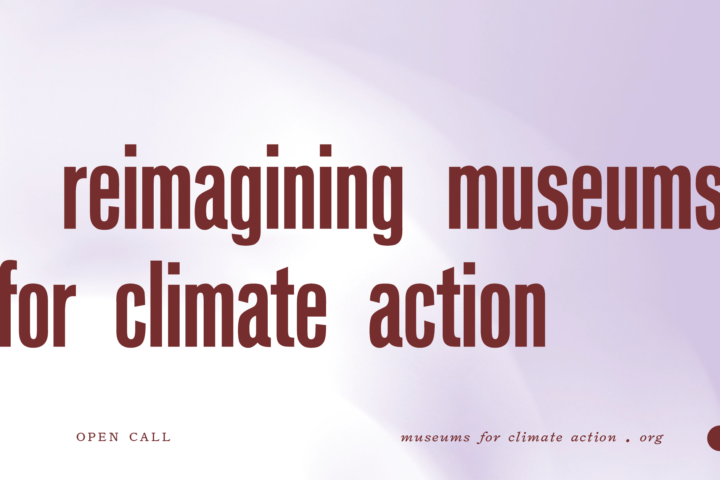COP26: Museums look to the future
What role should museums play in engaging the public with COP26?
By Kathy Grenville
Share
Last updated:
COP26: Museums look to the future
Over the past few decades, museums and the roles they play have evolved. They are moving from their more traditional roles as repositories of histories and explainers of the past to having a more active role in the development of our societies.
Increasingly, museums have become aware of their ability to tackle the issues of today. Exhibitions exploring our relationship with artificial intelligence or how fake news affects our lives are just some recent examples of museums branching out and encouraging us to look ahead.
Recently Sharon Heal, the Director of the Museums Association, said it was the responsibility of museums to hold exhibitions on the most pressing issues facing the UK.
So what role could and should they play in engaging the British public with COP26 and, more broadly, with climate change in general?
Despite its postponement until 2021, COP26, the annual summit of nations under the United Nations Framework Convention on Climate Change, is set to be a significant milestone. It will be the first COP to take place after the landmark Paris Agreement’s measures take effect and the first point since then at which nations are due to review commitments and strengthen ambition.
The extent to which the British public is aware of and engaged with COP26 will to some degree define its success.
Both the Framework Convention on Climate Change and the Paris Agreement recognise the importance of involving the public and empowering communities to counter climate change and adapt to its impacts. They both specify the importance of public education, training, public awareness, public participation, public access to information, and international cooperation. These six areas are popularly referred to as Action for Climate Empowerment (ACE) – and museums are specifically mentioned.
So what is the museum sector doing to ensure COP26 – this momentous summit – doesn’t just pass us by?

One example can be seen in the launch of a museum design competition for COP26 by the UK Arts and Humanities Research Council, led by Professor Rodney Harrison (UCL Institute of Archaeology (IoA)) and in partnership with Colin Sterling (IoA), Dr Emma Woodham (Glasgow Science Centre) and Henry McGhie (Curating Tomorrow).
The competition, ‘Reimagining Museums for Climate Action’, asks designers, architects, academics, artists, poets, philosophers, museum professionals and the public at large to radically (re)imagine and (re)design the museum as an institution, to help bring about more equitable and sustainable futures in the climate change era.
I caught up with Professor Rodney Harrison to find out more:
Where did the idea for the competition come from?

The competition aims to engage with the Action for Climate Empowerment (ACE) agenda for the implementation of Article 6 of the UN Framework Convention on Climate Change. The original Framework Convention on Climate Change and the Paris Agreement both recognise the importance of involving the public in climate action. We see that museums and heritage sites more generally, have a huge potential to support action for climate empowerment. There is something between 80 and 100 thousand museums in the world and they have millions of visitors every year and they have a whole world of resources that can potentially contribute towards climate action.
Why will COP26 provide a significant opportunity for museums and other cultural organisations?
There’s a dual fold opportunity here – one is that we haven’t seen a very strong engagement with the understanding of COP and what it’s about in the museum and heritage sector. So, the competition in one way is about highlighting COP and climate change issues more generally to this sector.
On the other hand, there is an opportunity to present work that’s going on within the heritage and museums sector to other climate change professionals and policymakers who will participate in COP. It will provide a significant opportunity for those both inside and outside of the heritage and museums sector, and those inside and outside of the broader COP communities, to highlight the significant resonances and opportunities for climate change action to be delivered by way of museums either as we understand them now or as we come to understand them.
What do you hope to see in contestants’ briefs?
We want to keep it as open as possible and we want to be surprised and provoked. We hope that by putting something like this to the public we will see really creative submissions that engage with the creative potential of museums as institutions, to rethink not only their role in the future but also the very institution of the museum for the future – how can museums really change and do we really want them to do?
Interest needs to be registered by 31st July 2020 to submit by the final deadline of 15th September 2020, and further information is available on the competition website: www.museumsforclimateaction.org
Eight competition winners will be awarded £2,500 each to develop their ideas, which will take centre stage in an exhibition at Glasgow Science Centre ahead of and during COP26 – where in turn they can expect to be seen by delegates from many countries and many different walks of life.
Share